The zonkey is a hybrid cross between a zebra and a donkey. Technically, a zonkey is the hybrid of a zebra father (sire) and a donkey mother (dam). Hybrids of a donkey father and zebra mother are called a “zedonk,” or sometimes a “donkra.” Hybrids of two types of zebra are commonly called “zebroid;” another hybrid is the “zorse,” which is a cross between a horse and a zebra.
Zebra/donkey hybrids do occur in nature, for example in South Africa, where zebras and donkeys live close to each other, but they are exceptionally rare. Zonkey hybrids have been bred in captivity since the 19th century. Read on to learn about the zonkey.
Description of the Zonkey
Zonkeys have a typical small horse shape. They are tan, brown, or gray in overall color, but with a lighter underside. The zonkey’s darker stripes are most prominent on these lighter parts of the body and their legs. They have a black mane which goes the entire length of the ridge of their back to the tip if their tail, which is also usually black. Their head and ears are both large, looking more like a donkey than a zebra.
Interesting Facts About the Zonkey
The zonkey is a hybrid cross, and although they exist in the wild, they are also seen as “curiosities” in zoos around the world. Because they are a cross of two animals, and have unusual features such as stripes that are only visible on some parts of the body, there are some interesting facts about the zonkey.
- Notability – The biologist Charles Darwin mentioned the possibility of a fertile female zonkey at the London Zoo
- Popularity – Zonkeys first became really prominent to the public when one was accidentally sired in the 1970s in the UK’s Colchester Zoo
- Power and Speed – Zonkeys are very strong, and very fast animals, capable of running 35 mph (60 kph).
Habitat of the Zonkey
In the wild, zonkeys live in typical zebra habitats, such as the savanna and open woodlands.
Distribution of the Zonkey
Zonkeys occur in the wild in Africa, but can also be found in zoos and other captive animal establishments around the world.
Diet of the Zonkey
Zonkeys are herbivores, eating only plant material. The vast majority of their diet consists of grasses and herbs that grow on the ground. They have flat, broad teeth for grazing and grinding down the fibrous grass. In less arid areas, they sometimes browse in trees and shrubs for other types of food, including fruits and berries. There are many other animal species which have very similar feeding habits to wild zonkeys, so they spend much of their time moving from area to area to find better food sources.
Conservation Status of the Zonkey
The zonkey is a cross-bred animal that cannot continue to propagate a population. Therefore, it is not listed by the International Union for Conservation of Nature (“IUCN”), and is not given an official conservation status. However, of the three zebra species, the plains zebra is listed as Least Concern, the mountain zebra as Vulnerable and the Grevy’s zebra as Endangered, making the chances of zonkeys occurring in the wild less and less.
Zonkeys and Human Interaction
Zonkeys are sometimes used as beasts of burden (work animals) because of their great strength and stamina. It is believed they inherit resistance to some pests and diseases from their zebra fathers. Some zoos use them to offer rides to the public.
Domestication
Donkeys have been domesticated for thousands of years, however, zebras are wild animals with quite an aggressive nature. Despite this, they are easily trained.
Does the Zonkey Make a Good Pet
Zonkeys do not make good pets because they seem to inherit, from their zebra parent, a tendency to be aggressive towards humans. This aggression is also sometimes directed toward other animals.
Zonkey Care
Zonkeys require similar care to that given to any other equid (horse-like animal).
Behavior of the Zonkey
The zonkey is a typical equid, in that they are grazing animals (sometimes browsing in the right conditions), and are active during the day (diurnal). They are a herd animal that seeks other zonkeys or equids.
Reproduction of the Zonkey
There are conflicting reports on whether zonkeys are sterile or fertile. They appear to have very low fertility, and therefore have problems reproducing. A donkey has 62 chromosomes, whereas the zebra has between 32 and 46 chromosomes, depending on the species (there are 3 species of zebra). This mismatch in chromosome numbers causes complications during cell division as the baby zonkey develops in the mother’s womb.
The pregnancy (gestation) of the mother donkey usually lasts about 12 months. The baby zonkey can walk within minutes of being born, and stays close to mom for 4 to 5 months before leaving the herd at about 4 years of age.


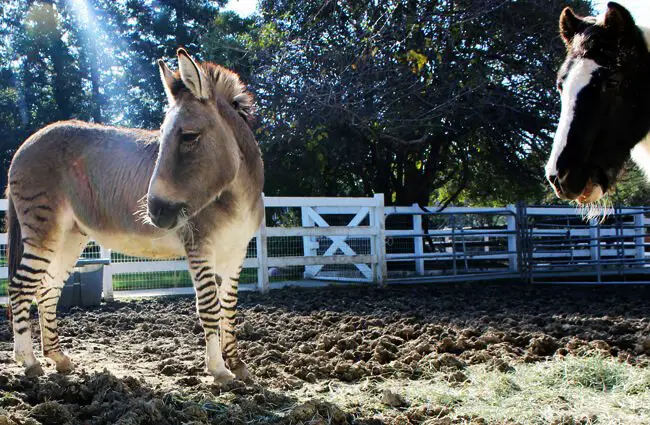

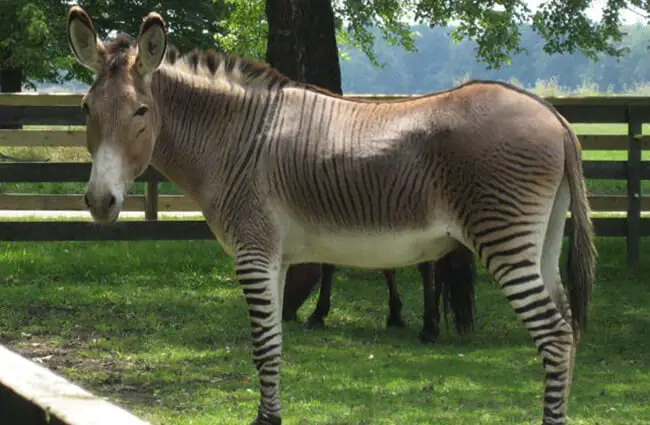

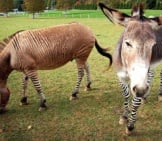
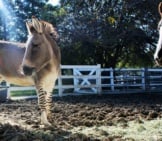


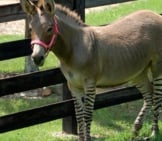
![Red Angus Closeup of a beautiful Red Angus cowPhoto by: U.S. Department of Agriculture [pubic domain]https://creativecommons.org/licenses/by/2.0/](https://animals.net/wp-content/uploads/2020/03/Red-Angus-4-238x178.jpg)












![Red Angus Closeup of a beautiful Red Angus cowPhoto by: U.S. Department of Agriculture [pubic domain]https://creativecommons.org/licenses/by/2.0/](https://animals.net/wp-content/uploads/2020/03/Red-Angus-4-100x75.jpg)

